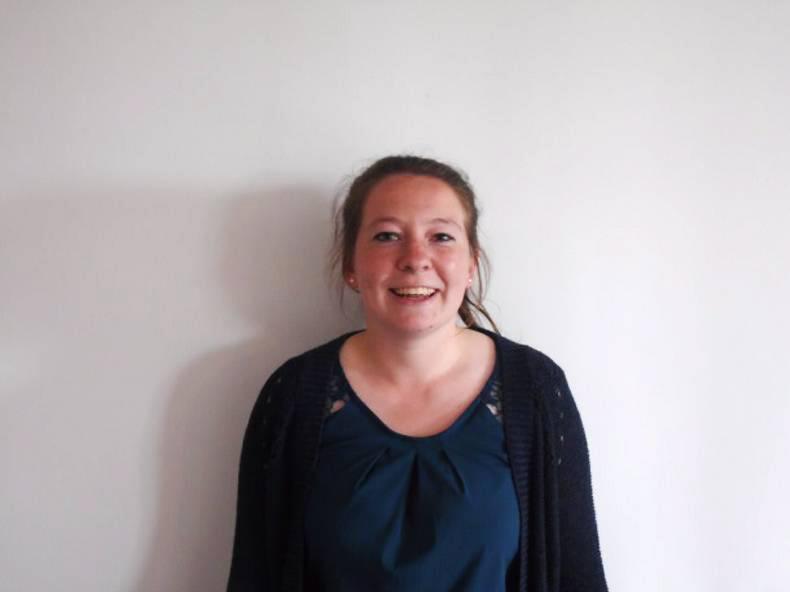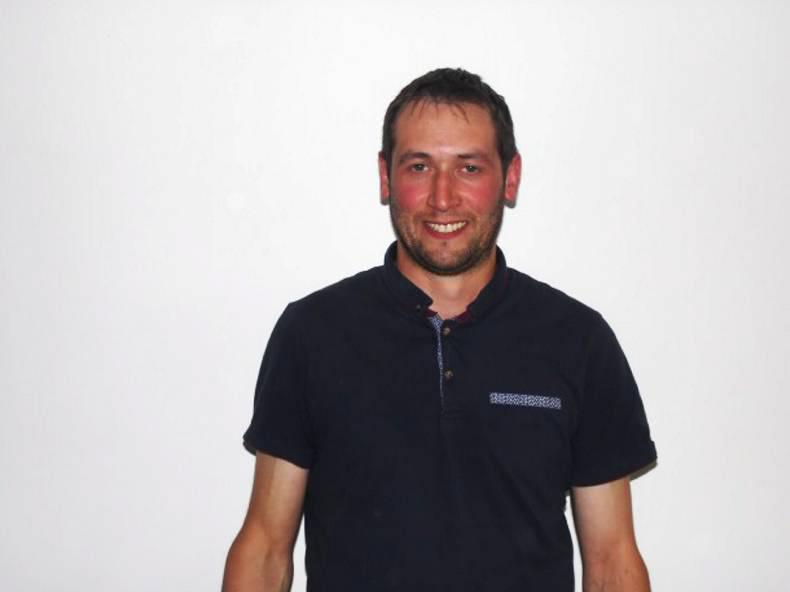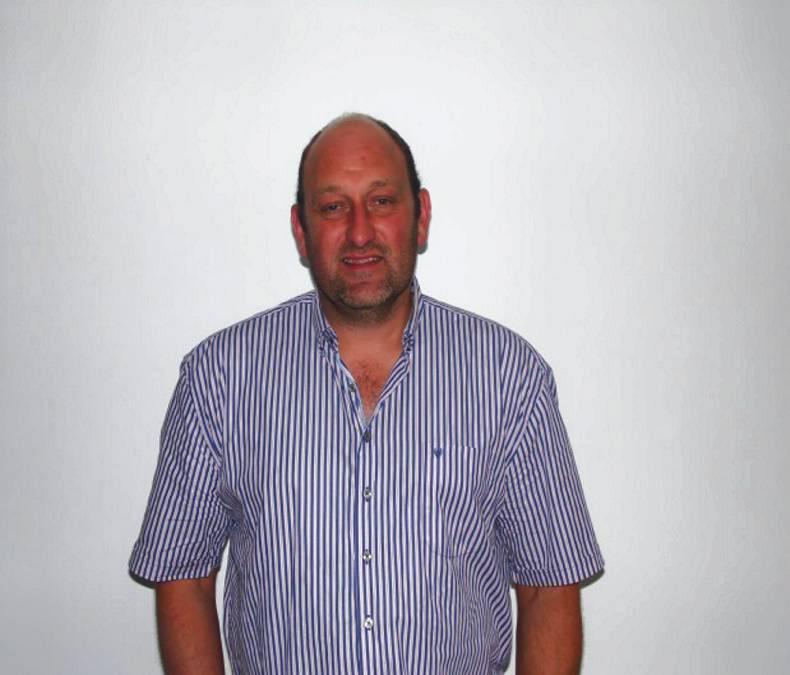Address: Puttaghaun, Tullamore, Co Offaly. 37ha
Education: Degree in Agricultural Science (Animal Science).
Currently undertaking a Masters in Agricultural Science.
Farming history
Farm in family for five generations.Traditionally livestock, tillage and contracting.Suckling system began in 2008.Brief description of current farming operations
Aisling farms part-time with her father Eddie.Tillage crops grown include winter and spring barley (out-farm).20 spring-calving suckler cows on home farm.70% of Cows are 4- and 5-star on the replacement index.100% AI used, breeding own replacements.Sell weanlings in October/November in local mart.Tradition of hay making; supplying a strong local market.Farm details
Herd
Mainly Continental X cows, with some Hereford and Angus.Replacements retained from top cows and bred to Limousin or Simmental AI sires which are 5-star on the replacement index.Remaining cows bred to 5-star terminal Limousin AI sires.Stocking rate
Currently 1.6 LU per adjusted ha, but has plans in place to increase to 2 LU/ha as suckler numbers increase to 30 cows.Grass
Rotational grazing system with three- to four-day grazing paddocks.Grass is measured each week and data is entered on PastureBase.Clover is maintained in swards with tight grazing.Surplus grass is baled as silage.The farm has huge potential to grow more grass as livestock numbers and demand increase.Key technologies adopted
1) Restricted suckling – Calves are separated from cows at approximately one week of age and allowed to suckle twice daily for four to six weeks. Cows start cycling earlier and it can help reduce the calving interval significantly.
2) AI – Cows are tail-painted weekly and monitored three to four times per day for signs of heat.
3) Scanning cows – 30 days after the breeding season ends.
4) Weighing calves – Calves are weighed twice during the grazing season and just before weaning. Weights are checked against target daily liveweight gain.
5) ICBF HerdPlus – Reports are used to make breeding and culling decisions. The Eurostar indexes are very useful when choosing cows to breed replacements from.
6) Soil fertility, grass measuring and rotational grazing – lime and fertiliser are spread based on soil sample results. Grass is measured on a weekly basis and three- to four-day grazing paddocks are set up.
7) Profit Monitor – Hugely beneficial in measuring farm output and monitoring costs. The profit monitor is the first step in creating a farm plan – it indicates current farm performance and highlights areas for improvement.
My future plans
Increase cow numbers to 30 by 2018.Keep all 4/5 star heifers.Breed heifers to an easy calving AI bull and sell in-calf as replacement heifers the following summer/autumn.Tighten calving spread and reduce calving interval further.Take soil samples and address soil fertility issues.Invest in grassland reseeding to match increased demand.Join KT groups and GLAS III. This source of funds will be used to invest in more fencing, water supply and grassland reseeding.Address: Coolfin, Portlaw, Co
Waterford.
Education: Certificate in Agriculture, Kildalton Agricultural College.
Farming history
Suckler farming in Partnership with my parents John and Anne.Started with 30 suckler cows after college.Dovea AI technician. (Four years).Teagasc Farm in Kildalton. (Two years).Farm work placement in Curraghmore Estate, Waterford.Brief description of current
farming operations
145 suckler-to-weanlings and yearlings on
82ha.60 autumn- and 85 spring-calving.AI used on 45 spring-calving cows.LMx cows bred with BB and LM Bulls – Sultan, Adajio and Serpentine, Casimir.Bull calves sold at ten months average weighting 408kg @ €2.41/kg (2016).Heifers sold at 380kg average
@ €2.40/kg (2015).Stocking rate 2.1 LU/ha.Technologies adopted
E-Profit Monitor each year.In KT discussion Group.ICBF Herd Plus.Weighing scales.Rotational Grazing System in place.AI used every year.Future plans
More roadways. To calve down 150 cows .Extra housing – planning received for slatted shed.Rear calves – buy in 30 calves.Addres: Fardystown, Murintown, Co Wexford.
Education: Fetac Level 6 Green Cert
Farming history
Started farming in 2012 on 40ha of grass, all owned.Farm previously used for sport horses.Reared 25 calves and fattened 20 heifers first year.Brief description of current farming operations
Full-time farming 54ha.Rearing 120 dairy calf-to-beef.60 reared before Christmas (Oct-Dec).60 reared in spring (Feb-March).Farm details
Stocking rate: 1.9 LU/ha.Grass:
Intensive rotational paddock system with permanent and temporary wire. Farmyard in the centre with roadways makes this a simple system.Over 50% of the farm has been reseeded.Measuring grass with plate meter and PastureBase Ireland.Discussion group
In a BTAP Discussion Group since 2013, and a Grass Group since 2015, both under Martina Harrington, Teagasc adviser.
Key technologies adopted
Rotational paddock grazing.Grass measuring.Making high-quality silage every year.Grass utilisation, taking out strong paddocks for silage.Soil testing to improve soil indexes, spreading Lime, P and K.Regularly weighing cattle.Complete a yearly Profit Monitor.My future plans
Increase stocking rate and kg/ha.Keep reseeding and improving soil fertility.Do yearly herd health plan.Increase grass growth and utilisation further.Increase housing facilities. Farming philosophy
Keep it simple, make it safe, get more efficient.Address: Cappagh, Callan, Co Kilkenny.
Education: Degree in Agricultural Science.
Farming history
Acquired Herd Number in 2008, on 8ha of owned land and 36ha leased from his father. Calved down 55 heifers first year.Brief description of current
farming operations
60 spring-calving suckler cows calving from late January to end of March.Purchasing 45 to 50 spring-born Friesian bull calves rearing to steer beef.Farming on his own, but shares machinery with his brother (dairy farmer).Farming 44ha (home), and 12ha (away) for three cut silage.Farm details
Herd
60 continental cows run in two groups of 30 each. Used AI on one group, and a Charolais bull on the other group, (then let this Charolais bull to the AI group to pick up on the few that were not in-calf). Also used Simmental, Parthenaise and Limousin AI on 10 heifers.Stocking rate
Stocked at 160kg organic N/ha with farm almost fully reseeded; scope to go to 200kg organic N/ha and above.Grass
Full reseeding almost complete, mainly by ploughing. Intensive paddock system with permanent and temporary wires and water troughs/roadways. Has commenced grass measuring with plate meter and PastureBase Ireland.Discussion group
Was in a BTAP discussion group for the last few years, has now joined the Mid-Kilkenny KT Suckler Discussion Group (Terry Carroll, Teagasc Adviser).Key technologies adopted
Grass reseeding and short duration paddocks.Grass measuring (eyeballing previous plate meter now).Soil tested whole farm and applied lime, P and K.Completes a yearly Profit Monitor.Making high-quality silage every year.Scales: Weighing cattle regularly to assess performance.My future plans
Push grass growth and utilisation further to produce more tons of quality beef from the land available.Address: Toberscarden, Tubbercurry, Co Sligo.
Education: qualified carpenter national crafts certificate.
Farming history
Farms 45ha.Pedigree Limousin breeder and contract rearer who commenced farming in 2011.Farms in partnership with his wife Caroline.Brief description of current farming
operations
35 autumn-calving pedigree Limousin cows calving from mid-Aug to mid Oct.100% AI usage with emphasis on the replacement index to sell bulls with high replacement values to commercial suckler farmers.Contract-rearing cattle from suckler and dairy herds over the grazing season.Farm details
Herd
Uses Limousin AI sires with high replacement values.Increase the number of dairy heifers contract reared, planning to keep heifers from two months of age to 22 months then return to herd of origin prior to calving.High herd health status (Limo leader herd Health Scheme).Stocking rate
Stocking rate low @ 1.1 LU/ha.Plan to increase from 1.1 to 1.8 LU/ha.Grass
Introduced water troughs and grazing paddocks to improve grassland management.Discussion group
In KT Group (Tom Coll – Teagasc adviser).Key technologies adopted
Grassland management (by introducing water troughs and rotational grazing).Measuring grass on PastureBase Ireland.Silage quality – has improved significantly.Uses ICBF HerdPlus for cow/bull selection, recording birth data, weights, etc.Purchased weighing scales, all cattle weighed regularly during the year to ensure preset growth targets are met.Profit Monitors and budgets completed early in the year.My future plans
Establish a 30-cow compact spring-calving herd calving Jan-March, selling high-quality weanlings in November.Produce pedigree bulls and heifers with high replacement values.Establish a long-term contract with a dairy herd rearing replacement heifers.Build a new shed for pedigree herd under TAMS II which will free up existing sheds to house contract-reared stock over the winter period. Read more
To read the full Beef 2016 Focus supplement click here.
Address: Puttaghaun, Tullamore, Co Offaly. 37ha
Education: Degree in Agricultural Science (Animal Science).
Currently undertaking a Masters in Agricultural Science.
Farming history
Farm in family for five generations.Traditionally livestock, tillage and contracting.Suckling system began in 2008.Brief description of current farming operations
Aisling farms part-time with her father Eddie.Tillage crops grown include winter and spring barley (out-farm).20 spring-calving suckler cows on home farm.70% of Cows are 4- and 5-star on the replacement index.100% AI used, breeding own replacements.Sell weanlings in October/November in local mart.Tradition of hay making; supplying a strong local market.Farm details
Herd
Mainly Continental X cows, with some Hereford and Angus.Replacements retained from top cows and bred to Limousin or Simmental AI sires which are 5-star on the replacement index.Remaining cows bred to 5-star terminal Limousin AI sires.Stocking rate
Currently 1.6 LU per adjusted ha, but has plans in place to increase to 2 LU/ha as suckler numbers increase to 30 cows.Grass
Rotational grazing system with three- to four-day grazing paddocks.Grass is measured each week and data is entered on PastureBase.Clover is maintained in swards with tight grazing.Surplus grass is baled as silage.The farm has huge potential to grow more grass as livestock numbers and demand increase.Key technologies adopted
1) Restricted suckling – Calves are separated from cows at approximately one week of age and allowed to suckle twice daily for four to six weeks. Cows start cycling earlier and it can help reduce the calving interval significantly.
2) AI – Cows are tail-painted weekly and monitored three to four times per day for signs of heat.
3) Scanning cows – 30 days after the breeding season ends.
4) Weighing calves – Calves are weighed twice during the grazing season and just before weaning. Weights are checked against target daily liveweight gain.
5) ICBF HerdPlus – Reports are used to make breeding and culling decisions. The Eurostar indexes are very useful when choosing cows to breed replacements from.
6) Soil fertility, grass measuring and rotational grazing – lime and fertiliser are spread based on soil sample results. Grass is measured on a weekly basis and three- to four-day grazing paddocks are set up.
7) Profit Monitor – Hugely beneficial in measuring farm output and monitoring costs. The profit monitor is the first step in creating a farm plan – it indicates current farm performance and highlights areas for improvement.
My future plans
Increase cow numbers to 30 by 2018.Keep all 4/5 star heifers.Breed heifers to an easy calving AI bull and sell in-calf as replacement heifers the following summer/autumn.Tighten calving spread and reduce calving interval further.Take soil samples and address soil fertility issues.Invest in grassland reseeding to match increased demand.Join KT groups and GLAS III. This source of funds will be used to invest in more fencing, water supply and grassland reseeding.Address: Coolfin, Portlaw, Co
Waterford.
Education: Certificate in Agriculture, Kildalton Agricultural College.
Farming history
Suckler farming in Partnership with my parents John and Anne.Started with 30 suckler cows after college.Dovea AI technician. (Four years).Teagasc Farm in Kildalton. (Two years).Farm work placement in Curraghmore Estate, Waterford.Brief description of current
farming operations
145 suckler-to-weanlings and yearlings on
82ha.60 autumn- and 85 spring-calving.AI used on 45 spring-calving cows.LMx cows bred with BB and LM Bulls – Sultan, Adajio and Serpentine, Casimir.Bull calves sold at ten months average weighting 408kg @ €2.41/kg (2016).Heifers sold at 380kg average
@ €2.40/kg (2015).Stocking rate 2.1 LU/ha.Technologies adopted
E-Profit Monitor each year.In KT discussion Group.ICBF Herd Plus.Weighing scales.Rotational Grazing System in place.AI used every year.Future plans
More roadways. To calve down 150 cows .Extra housing – planning received for slatted shed.Rear calves – buy in 30 calves.Addres: Fardystown, Murintown, Co Wexford.
Education: Fetac Level 6 Green Cert
Farming history
Started farming in 2012 on 40ha of grass, all owned.Farm previously used for sport horses.Reared 25 calves and fattened 20 heifers first year.Brief description of current farming operations
Full-time farming 54ha.Rearing 120 dairy calf-to-beef.60 reared before Christmas (Oct-Dec).60 reared in spring (Feb-March).Farm details
Stocking rate: 1.9 LU/ha.Grass:
Intensive rotational paddock system with permanent and temporary wire. Farmyard in the centre with roadways makes this a simple system.Over 50% of the farm has been reseeded.Measuring grass with plate meter and PastureBase Ireland.Discussion group
In a BTAP Discussion Group since 2013, and a Grass Group since 2015, both under Martina Harrington, Teagasc adviser.
Key technologies adopted
Rotational paddock grazing.Grass measuring.Making high-quality silage every year.Grass utilisation, taking out strong paddocks for silage.Soil testing to improve soil indexes, spreading Lime, P and K.Regularly weighing cattle.Complete a yearly Profit Monitor.My future plans
Increase stocking rate and kg/ha.Keep reseeding and improving soil fertility.Do yearly herd health plan.Increase grass growth and utilisation further.Increase housing facilities. Farming philosophy
Keep it simple, make it safe, get more efficient.Address: Cappagh, Callan, Co Kilkenny.
Education: Degree in Agricultural Science.
Farming history
Acquired Herd Number in 2008, on 8ha of owned land and 36ha leased from his father. Calved down 55 heifers first year.Brief description of current
farming operations
60 spring-calving suckler cows calving from late January to end of March.Purchasing 45 to 50 spring-born Friesian bull calves rearing to steer beef.Farming on his own, but shares machinery with his brother (dairy farmer).Farming 44ha (home), and 12ha (away) for three cut silage.Farm details
Herd
60 continental cows run in two groups of 30 each. Used AI on one group, and a Charolais bull on the other group, (then let this Charolais bull to the AI group to pick up on the few that were not in-calf). Also used Simmental, Parthenaise and Limousin AI on 10 heifers.Stocking rate
Stocked at 160kg organic N/ha with farm almost fully reseeded; scope to go to 200kg organic N/ha and above.Grass
Full reseeding almost complete, mainly by ploughing. Intensive paddock system with permanent and temporary wires and water troughs/roadways. Has commenced grass measuring with plate meter and PastureBase Ireland.Discussion group
Was in a BTAP discussion group for the last few years, has now joined the Mid-Kilkenny KT Suckler Discussion Group (Terry Carroll, Teagasc Adviser).Key technologies adopted
Grass reseeding and short duration paddocks.Grass measuring (eyeballing previous plate meter now).Soil tested whole farm and applied lime, P and K.Completes a yearly Profit Monitor.Making high-quality silage every year.Scales: Weighing cattle regularly to assess performance.My future plans
Push grass growth and utilisation further to produce more tons of quality beef from the land available.Address: Toberscarden, Tubbercurry, Co Sligo.
Education: qualified carpenter national crafts certificate.
Farming history
Farms 45ha.Pedigree Limousin breeder and contract rearer who commenced farming in 2011.Farms in partnership with his wife Caroline.Brief description of current farming
operations
35 autumn-calving pedigree Limousin cows calving from mid-Aug to mid Oct.100% AI usage with emphasis on the replacement index to sell bulls with high replacement values to commercial suckler farmers.Contract-rearing cattle from suckler and dairy herds over the grazing season.Farm details
Herd
Uses Limousin AI sires with high replacement values.Increase the number of dairy heifers contract reared, planning to keep heifers from two months of age to 22 months then return to herd of origin prior to calving.High herd health status (Limo leader herd Health Scheme).Stocking rate
Stocking rate low @ 1.1 LU/ha.Plan to increase from 1.1 to 1.8 LU/ha.Grass
Introduced water troughs and grazing paddocks to improve grassland management.Discussion group
In KT Group (Tom Coll – Teagasc adviser).Key technologies adopted
Grassland management (by introducing water troughs and rotational grazing).Measuring grass on PastureBase Ireland.Silage quality – has improved significantly.Uses ICBF HerdPlus for cow/bull selection, recording birth data, weights, etc.Purchased weighing scales, all cattle weighed regularly during the year to ensure preset growth targets are met.Profit Monitors and budgets completed early in the year.My future plans
Establish a 30-cow compact spring-calving herd calving Jan-March, selling high-quality weanlings in November.Produce pedigree bulls and heifers with high replacement values.Establish a long-term contract with a dairy herd rearing replacement heifers.Build a new shed for pedigree herd under TAMS II which will free up existing sheds to house contract-reared stock over the winter period. Read more
To read the full Beef 2016 Focus supplement click here.






 This is a subscriber-only article
This is a subscriber-only article













SHARING OPTIONS: